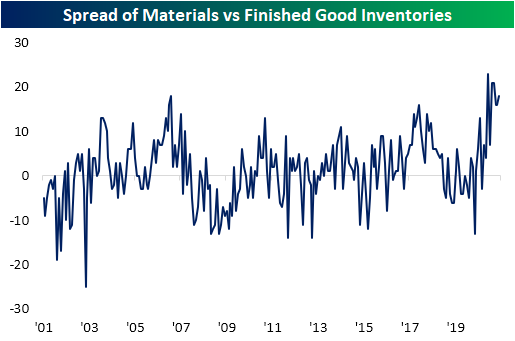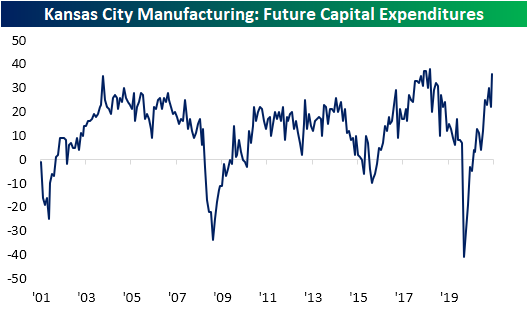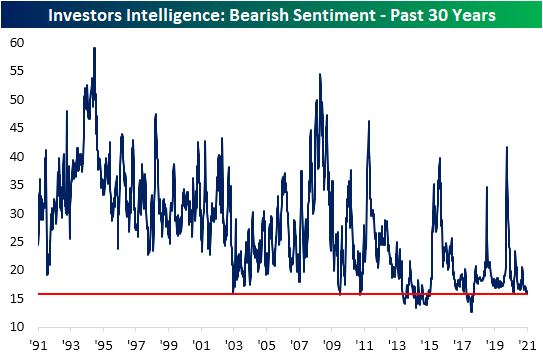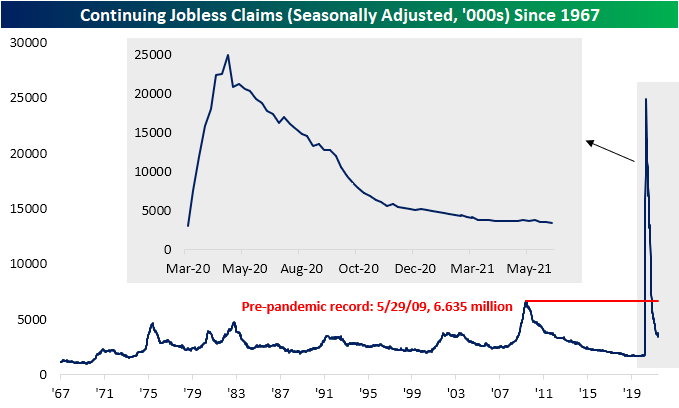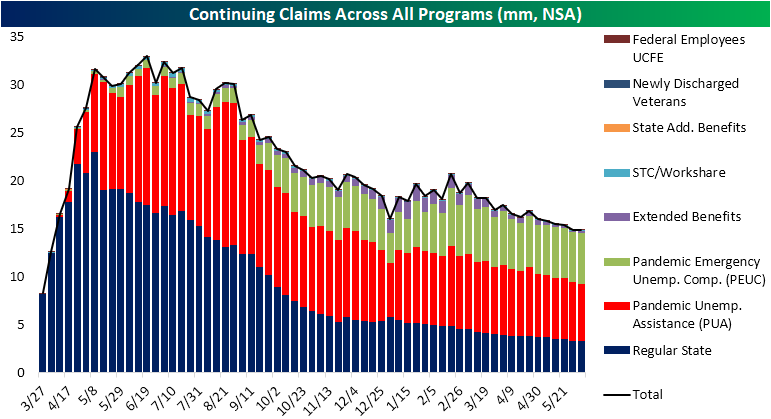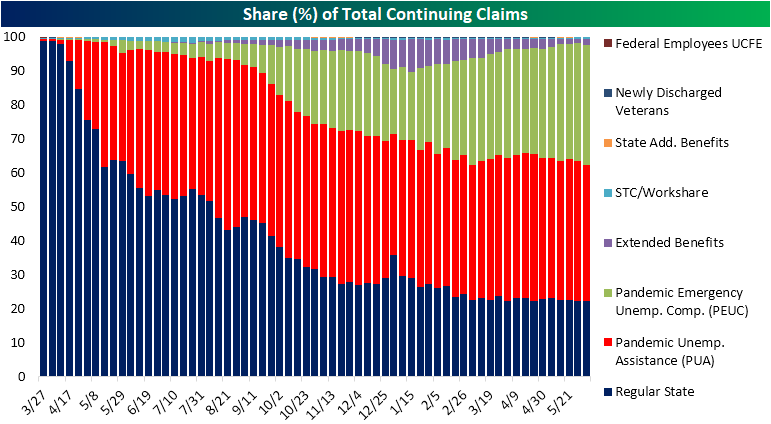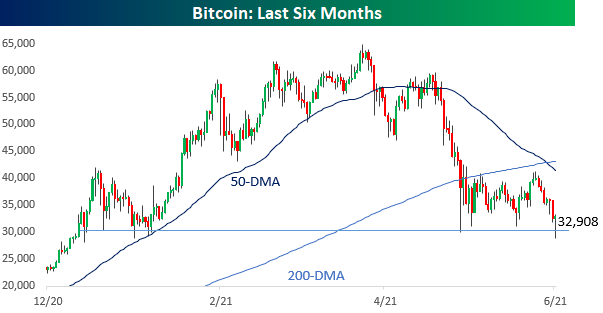Bespoke Brunch Reads: 6/27/21
Welcome to Bespoke Brunch Reads — a linkfest of the favorite things we read over the past week. The links are mostly market related, but there are some other interesting subjects covered as well. We hope you enjoy the food for thought as a supplement to the research we provide you during the week.
While you’re here, join Bespoke Premium with a 30-day free trial!
The Fed
The Federal Reserve Is at the Nexus of the Inflation Debate. Here’s How It Works by Matthew C. Klein (Barron’s)
An excellent explainer on the institutional structure of the Federal Reserve. This is helpful reference material for understanding the basics of how the central bank operates. [Link; paywall]
Chips
Crypto-miners are probably to blame for the graphics-chip shortage (The Economist)
Data and explanation illustrating how the market for graphics processing units are being driven by prices for the cryptocurrency Ethereum over time, contributing to high prices for gamers and other GPU users. [Link; paywall]
Automotive chip suppliers gearing up for output ramp-up by Cage Chao (DigiTimes Asia)
After auto OEMs cancelled orders for chips en masse when COVID hit, production runs were shifted to other customers, creating huge headaches when car companies restarted orders. Now, vendors are restarting shipments, with customers being told they can expect a 30% increase in shipments in the second half. [Link; paywall]
Climate
Tiny Satellites Could Help Warn of the Next Big Hurricane by Meghan Herbst (Wired)
A small constellation of microsatellites will be used to keep an eye on the tropical zone that spawns hurricanes and cyclones which are so threatening to coastal areas in warmer lattitudes. [Link; soft paywall]
SEC Wants More Climate Disclosures. Businesses Are Preparing for a Fight. by Dave Michaels (WSJ)
Efforts to require companies to disclose climate change risks face a number of hurdles, including open questions about what the SEC is actually able to require companies to share with investors. [Link; paywall]
China
American Basketball Pro Spent Eight Months in Secretive China Detention by James T. Areddy (WSJ)
After being implicated in the death of a man, an American basketball pro spent 8 months in a Chinese detention facility that left him 40 pounds lighter. The case sheds critical light on the practice of residential detention in China. [Link; paywall]
Chinese Port Logjam Threatens Christmas Shipping Rush by Costas Paris (WSJ)
A COVID outbreak in the Yantian port in southern China has led to 50 container ships and more than 350,000 containers stranded in a backlog that has wreaked havoc on logistics for companies of all kinds. [Link; paywall]
‘Dragon Man’ Skull Discovery in China Tells Story of Unknown Human Ancestor by Robert Lee Hotz (WSJ)
In 1933, a farmer stashed a human skull in a well to keep it safe from invading Japanese forces. A study of the skull published this week suggests that near-human ancestors were resident in China 146,000 years ago. [Link; paywall]
Complex Systems
Stewardship of global collective behavior by Joseph B. Bak-Coleman et al (PNAS)
An effort to grapple with what the shift to algorithm-driven social media has meant for social stability; the authors focus on factors including scale and incentives, with social media networks operating with global reach and focusing on amplification of attention and engagement rather than accuracy. [Link]
History
“We believe in making treason odious:” U.S. Veterans of the Civil War Attack the Lost Cause (Angry Staff Officer)
The history of how Union veterans reacted to the rise of the Lost Cause ideology which did so much to flatter the treason of slave states against the United States during the Civil War. [Link]
EVs
Confessions Of A Sidewalk Charger by Joe Wachunas (CleanTechnica)
While it’s certainly possible and legal to charge your street-parked electric vehicle using an extension cord, sidewalk charging is safer and more effective with a proper installation. [Link]
Read Bespoke’s most actionable market research by joining Bespoke Premium today! Get started here.
Have a great weekend!
Earnings Performance Turnaround
In late 2020 and early 2021, although companies were reporting extremely strong top and bottom line numbers as well as raising forward guidance at a high rate, share prices were reacting very negatively to the news. As shown below in the snapshot from our Earnings Explorer tool, 2,050 stocks reported earnings in the first quarter (1/1/21-3/31/21). For both EPS and sales, 74% of companies beat consensus analyst estimates in Q1, while 15% of companies raised forward guidance versus just 5% lowering guidance. Even with the strong earnings numbers, though, the average one-day share price change for the 2,050 stocks that reported was -0.69%. On average, stocks that reported opened higher by 0.14% in reaction to the earnings news but then sold off by 0.81% from the open to the close of trading.

Although it’s currently the earnings off-season when only a handful of companies are reporting numbers each day, we’re seeing the tide turn lately when it comes to share-price reactions to earnings. As shown in another snapshot below from our Earnings Explorer, 178 companies have reported earnings over the last month. Beat rates remain incredibly strong with 84% of companies beating EPS estimates and 88% of companies beating sales estimates! Guidance also continues to come in hot with a whopping 28% of companies raising guidance versus just 4% lowering.
And whereas strong earnings results were not being met with buying in Q1, investors look to finally be willing to “buy the news” again. The 178 companies that have reported over the last month have averaged a one-day gain of 0.90% on their earnings reaction days. If we break the reaction day up into the initial opening gap and the open to close change, we see that the average stock that has reported has opened higher by 0.76% in reaction to the earnings news and then continued higher by another 0.11% from the open to the close of trading.
As shown in the top-right chart in the snapshot below, we have a “stock price reaction” tracker in our Earnings Explorer that helps users see how companies are reacting to reports over time. The reading shows the median one-day share price change for all companies that have reported earnings over the prior three months. At the end of Q1, this reading had dipped to five-year lows, meaning stocks were reacting more poorly to earnings than at any time since at least 2016. Over the last few months, this reading has been ticking higher and higher although it’s still negative. As more reports from late March and April roll off the 3-month tracker, however, the reading should tick back into positive territory soon provided the current trend of more positive reactions continues.

Our Earnings Explorer also allows users to dive into how individual stocks have reacted to earnings reports over time. We mentioned above that stocks that have reported over the last month have generally been reacting positively to the news. Below we show the stocks that have seen the biggest one-day gains in reaction to earnings over the last month. Furniture retailer Conn’s (CONN) had the best one-day move in reaction to earnings when it gained 27% back on June 3rd. Titan Machinery (TITN) and Cloudera (CLDR) are two more stocks that gained more than 20% on their earnings reaction days within the last month. Other names on the list below include DocuSign (DOCU), Dick’s (DKS), RH, Plug Power (PLUG), and Zscaler (ZS). All of the stocks in the table below gained at least 10% on their recent earnings reaction days.

Even though the average stock has posted a nice gain in reaction to earnings over the last month, there have still been a few losers. Below are the thirteen stocks that fell at least 10% in reaction to recent earnings reports. The king of the meme stocks — GameStop (GME) — actually tops the list with a 27% decline experienced back on June 10th after reporting after the close on June 9th. Click here to see how to gain access to our Earnings Explorer tool and the rest of our research package.

Bespoke’s Morning Lineup – 6/25/21 – Nike Just Does It
See what’s driving market performance around the world in today’s Morning Lineup. Bespoke’s Morning Lineup is the best way to start your trading day. Read it now by starting a two-week free trial to Bespoke Premium. CLICK HERE to learn more and start your free trial.
“Beating the competition is relatively easy. Beating yourself is a never-ending commitment.” – Phil Knight
Futures are modestly higher this morning for both the Nasdaq and S&P 500 as investors look to close out an already positive week for stocks on a good note. Economic data released this morning was mixed, but important readings in inflation were either in line with or slightly below expectations. The only other report on the calendar is Michigan Confidence at 10 AM, plus a number of FOMC speakers throughout the day.
Read today’s Morning Lineup for a recap of all the major market news and events from around the world, updates on economic data from Asia and Europe, the latest US and international COVID trends including our vaccination trackers, and much more.
Dow futures are leading the charge this morning, but if it weren’t for Nike (NKE), they’d actually be modestly low. After a blowout report last night, NKE is indicated to open up by over 13% to record highs, breaking its trend of lower highs that had been in place since earlier in the year in the process.

Kansas City Fed Shows Cap Ex Is Ramping Up
The Kansas City Fed released the results of their June survey of the region’s manufacturing sector this morning. Like the Richmond Fed reading two days ago and the Markit PMI yesterday, the composite index saw an uptick in June indicating some acceleration in manufacturing activity. The index rose one point to 27 which also exceeded expectations that were calling for the composite to fall further to 24 after a five-point drop last month. Similar to other regional Fed surveys, while the readings on current conditions have peaked, outlooks are cheerier with the index for expectations reaching a record high of 37 in June.
While the composite index for future expectations was the only category of the survey to come in at a record high, many other indices are similarly in the top few percentiles of their historical ranges. Consistent with other regions, breadth in this month’s report was a bit mixed with more categories declining than rising month over month. Regardless, even after those declines, these indices point to robust growth, long lead times, higher prices, and attempts to take on more workers amidst worker shortages.
One of the main areas to have seen declines concern demand and output. New Orders saw a particularly large decline with the 13 point drop ranking in the bottom decile of all monthly changes. That brought the index to the lowest level in four months. Production and Shipments also saw deceleration although to a lesser extent than New Orders. With order growth hitting the brakes but still at healthy levels, backlogs continue to grow at a historic rate. Granted, that is not as bad as earlier this spring.
The indices tracking inventories for materials and finished goods both declined in June, but material inventories are growing at a much faster clip of the two and expectations are just off a record high. Additionally, while the region’s manufacturing firms report fairly modest growth in current finished good inventories, expectations are more positive with that index hitting the highest level in three years. Regardless, as shown in the chart below, the spread between inventory levels of inputs and outputs has been at some of the highest levels on record over the past several months with another uptick this month. In other words, manufacturers appear to be having some trouble building finished good inventories.
One theme of the report’s commentary and special questions was a labor shortage. That potentially could be a reason for the aforementioned disconnect in material and finished good inventories. In spite of that labor shortage, the index for Number of Employees rose 6 points in June to the top 1% of all readings. While expectations declined sequentially, this month’s reading was also still above any reading on record outside of the past three months. Similarly, Average Workweek continues to come in at strong levels while expectations tied June 2018 for a record high. So while firms are stating they cannot find workers, they are still taking on new employees at a historically strong clip.
As for the other side of the production function, firms are also rapidly increasing plans to increase Capital Expenditure. The index tracking this metric saw one of the biggest one-month increases on record which brought it to the highest level since September 2018. Additionally, in the special questions of the survey, 41% of respondents said they are planning to increase investment in labor-saving automation on account of labor shortages. Another 17% planned to keep the same pace of investment as in the past. Overall, manufacturers are reporting strong albeit slowing demand, and to keep up with it, they are trying to take on more workers but shortages are affecting an ability to hire. As a result, more businesses are beginning to invest in capital. Click here to view all of Bespoke’s premium membership options and sign up for a trial.
Chart sources: Federal Reserve Bank of Kansas City
Housing: More Affordable Than It Looks
With the surge in home prices since the COVID pandemic hit, there are big concerns that housing has become much less affordable. But context is important. In addition to the price of a house, affordability should also take into account income supporting a given purchase and the interest cost of the debt borrowed to buy a home. In the first chart below, we take the median existing home sales price, assume a 20% down payment, and then calculate the implicit monthly payment cost to cover it based on national average mortgage rates. Then account for changes in income over time by expressing that dollar payment amount in terms of hourly wages, specifically the average hourly wage of production and non-supervisory employees. As shown in the chart, relative to labor income and interest rates, housing does not look particularly unaffordable at all, with 44.7 hours of work covering a monthly payment. That compares to around 55 hours in the early-2000s (prior to the subprime bubble) and 40 hours in the mid-2010s. Of course, lower interest rates do not help with down payments.
The median existing home’s down payment has soared in hours worked terms. It’s worth remembering, though, that first-time buyers can put down as little as 5%, and even twice that much down requires substantially fewer hours worked than a 20% down payment required in the late 1990s or early 2000s.
Taken together, we would argue that for existing homes, the current market is challenging, but that the level of home prices are not wildly unsustainable, and actually make quite a lot of sense.
While the new home market is a much smaller segment of the housing market and tends to target existing owners rather than new buyers, we still think performing a similar analysis is helpful. When we do, we see a very similar story as the one told by the existing home market but with a much longer-term data set. As shown, the monthly carrying cost of a new home is low versus history in hourly wage terms, though it has increased somewhat in the last few months. We also note that while the down payment for new homes is high versus wages, the current level is below the pre-COVID peak as well as the subprime bubble peak. New home prices have been far more under control than existing home prices, so if anything, affordability is even better for new home buyers. Bottom line: home prices are rising quickly and that appears to be stifling demand, but the rapid price increases of the last 18 months have largely been offset by large gains for hourly wages and the drop in interest rates over the same period. Click here to view Bespoke’s premium membership options.
Chart sources: National Association of Realtors, US Census Bureau, Bureau of Labor Statistics, Federal Reserve, Freddie Mac, FRED, Bespoke Investment Group Calculations
Bears in Hibernation
The S&P 500’s dip below its 50-DMA and the corresponding rally to new all-time highs did little to dramatically change investor sentiment. This week’s survey results from the AAII saw bullish sentiment fall slightly from 41.1% last week to 40.4%. That is once again within the past several weeks’ range at the lowest level since only two weeks ago.
Bearish sentiment was also lower this week, falling by 2.9 percentage points to 23.3%. As with bullish sentiment, that is the lowest level in two weeks. From a longer-term perspective, bearish sentiment is more than 7 percentage points below its historical average of 30.5%. In other words, while sentiment is not exuberant, it continues to skew optimistic.
The historically muted level of bearish sentiment also shows up in the Investors Intelligence survey of newsletter writers. This week, that reading fell half of one percentage point to 15.8%. That is the lowest percentage of respondents reporting as bearish since March 14th, 2018. Over the past 30 years, there have been only a handful of other periods with lower levels of market pessimism.
Pivoting back to the AAII survey, with bearish sentiment historically muted, a larger share of investors are reporting as neutral. 36.6% of respondents reported as such this week, up 3.9 percentage points from the six-week low last week. Click here to view all of Bespoke’s premium membership options and sign up for a trial.
Claims Disappoint But Resume Improvements
Last week, jobless claims saw a significant one-week uptick off the pandemic lows, and while claims are still elevated around some of the highest levels since mid-May, there was an improvement this week with a 7K decline to 411K. Granted, that also did not live up to expectations of a decline back down to 380K which would have been just 6K above the pandemic low.
On a non-seasonally adjusted basis, claims through regular state programs actually came in below 400K falling 14.7K to 393.1K. A sequential decline in the non-seasonally adjusted number for the current week of the year is somewhat unusual as this reading on jobless claims has historically risen two-thirds of the time. While regular state claims were lower, claims through the Pandemic Unemployment Assistance (PUA) program were higher. The past several weeks have seen steady improvements in PUA claim counts with a low of 71.2K at the beginning of the month, but after rising for two straight weeks now, it is back above 100K for the first time since the first week of May.
Since the last week of April, continuing jobless claims have been pretty choppy with every other week seeing a rise in claims. Granted, the weeks in between in which claims have fallen have seen larger declines than the previous week’s increase. This week was yet another example of this as claims fell 144K to erase last week’s 17K uptick which brought claims to a new pandemic low of 3.39 million. In other words, continuing claims are not improving in as consistent of a manner as they did for most of the past year, but nonetheless, they have continued to improve.
When including other programs on top of regular state claims, the improvements have been more consistent, but the most recent week (June 4th) did see a small uptick in total claims from 14.866K to 14.871K. In the charts below we show continuing claim counts (non-seasonally adjusted) for all programs. This data is lagged an additional week to the most recent release of claims for regular state programs, but the overall trend continues to be one of improvement. While total claims were higher, the PUA program did experience a large 175K decline, although that was offset by a 107.9K uptick in PEUC claims and a 97.7K increase in Extended Benefits. We would also note, as we did last week, that this is the last week of data before half of the states began to withdraw from pandemic era unemployment relief. that means data in the weeks to come is likely to see overall claim counts fall on account of fewer states reporting for certain programs. Click here to view Bespoke’s premium membership options.
Bespoke’s Morning Lineup – 6/24/21 – Semi Stall
See what’s driving market performance around the world in today’s Morning Lineup. Bespoke’s Morning Lineup is the best way to start your trading day. Read it now by starting a two-week free trial to Bespoke Premium. CLICK HERE to learn more and start your free trial.
“Altogether too often, people substitute opinions for facts and emotions for analysis.” – Andrew S. Grove
The Nasdaq is looking to make it four in a row today as US futures are higher across the board. Optimism on a possible breakthrough in infrastructure negotiations as well as some dovish commentary from the BoE are providing catalysts for today’s move. There’s a very big slate of economic data on the calendar, though, as well as a number of Fed officials scheduled to speak, so investors will have to navigate through all of these throughout the day. Early data released so far have generally been in line to weaker than expected, and the yield on the 10-year US Treasury is still below 1.5% down to 1.48%.
Read today’s Morning Lineup for a recap of all the major market news and events from around the world, updates on confidence data from Europe and Canada, the latest US and international COVID trends including our vaccination trackers, and much more.
We’ve seen the pattern below for the semiconductor index in a lot of areas of the market lately, especially the ones that were big winners last year. The Philadelphia Semiconductor Index isn’t far from its record highs in April, but it has essentially been in a sideways range for the last six months, a period in which it has traded in a relatively narrow range of 21.4%. As the group looks to bounce from here, if it can’t break out to new highs, or even stalls out short of its high a few days ago, look for technicians to start calling out a loose head and shoulders pattern.

Semiconductor stocks have become less volatile as the group has matured, but even the recent range is on the low side of the historical average. As shown in the chart below, the current six-month range for the stock is the narrowest since October 2018.

Bespoke’s Morning Lineup – 6/23/21 – The More Things Change…
See what’s driving market performance around the world in today’s Morning Lineup. Bespoke’s Morning Lineup is the best way to start your trading day. Read it now by starting a two-week free trial to Bespoke Premium. CLICK HERE to learn more and start your free trial.
“The only constant in the technology industry is change.” – Marc Benioff
Change may always be afoot when it comes to technology, but for the Nasdaq, there hasn’t been much change over the last two days as the index rallied 111 points (+0.79%) on both Monday and Tuesday! Even more ironic when it comes to change is that yesterday Microsoft (MSFT) became just the second US company to ever have a market cap of more than $2 trillion. Microsoft has seen a lot of change over the last two decades, but just like back in the late 1990s and early 2000s it remains right near the top of the list when it comes to being one of the most valuable companies in the world.
Futures are pointing to a modestly higher open this morning while the 10-year yield is exactly unchanged. Besides updates on PMI readings from Markit, New Home Sales will be released at 10:00 AM eastern, and there’s a number of Fed speakers on the calendar.
Read today’s Morning Lineup for a recap of all the major market news and events, an update on the Delta variant, overnight economic data, and the latest US and international COVID trends including our vaccination trackers, and much more.
With the Nasdaq up over 1.5% in the first two trading days of the week, the Technology sector traded at a new record high yesterday taking out its highs from April. Since the October lows, Technology has underperformed the broader market but it has been trading in a steady uptrend with higher highs and higher lows.

Bitcoin Hangs on to 30K
It has been a roller-coaster ride for bitcoin today. After breaking below $32K, then $31K, $30K, and $29K all within a matter of hours, buyers stepped in and prices rebounded back above $32K. Over the course of the day, bitcoin prices were down over 11% versus the prior day’s close but have rebounded more than 14% off the intraday lows. A 10% intraday decline coupled with a 10% intraday bounce is practically unheard of in the equity markets, but for bitcoin, it has become increasingly common. This year alone, today’s reversal marks the fifth such intraday rebound of 10%+ following a 10%+ intraday decline, although it only happened twice in 2020 and three times in 2018.
As far as bitcoin’s price chart is concerned, today’s bounce represents another in what is becoming a long list of testing the $30K level. It happened twice back in January before bitcoin rocketed above $60K and has now happened four times since prices started to fall in early May. When it comes to technicals, the more often a security tests support or resistance, the weaker it is considered to become. If that holds true with bitcoin, a few more tests of that level in the short term could open the floodgates to the downside.
Even after today’s bounce in bitcoin, its price is still over 48% below its all-time high reached just over two months ago in mid-April. While 48% sounds pretty steep, it looks like a walk in the park compared to prior drawdowns. Following peaks back in early 2011, early 2013, late 2013, and late 2017, bitcoin’s price fell anywhere from 70% to 93% each time. Even more surprising is the fact that since the start of 2011, bitcoin’s average percentage spread between its closing price on a given day and the all-time high as of that date was 48% – which is right where it is now. Click here to view all of Bespoke’s premium membership options and sign up for a trial.




